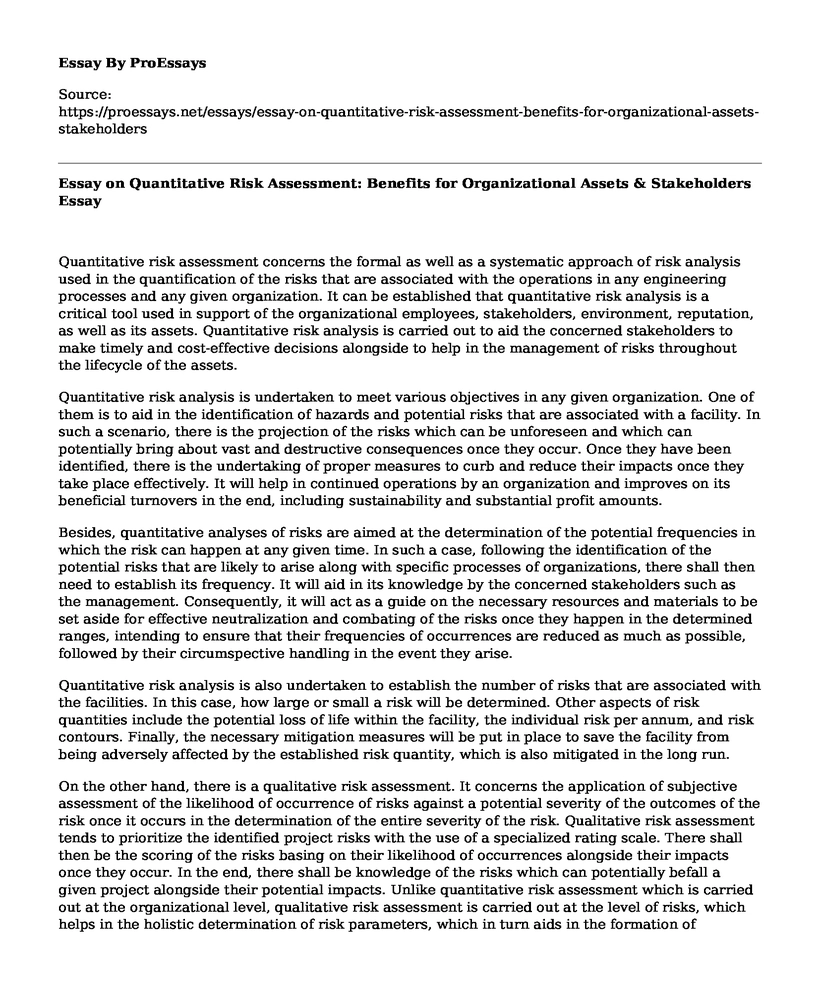Quantitative risk assessment concerns the formal as well as a systematic approach of risk analysis used in the quantification of the risks that are associated with the operations in any engineering processes and any given organization. It can be established that quantitative risk analysis is a critical tool used in support of the organizational employees, stakeholders, environment, reputation, as well as its assets. Quantitative risk analysis is carried out to aid the concerned stakeholders to make timely and cost-effective decisions alongside to help in the management of risks throughout the lifecycle of the assets.
Quantitative risk analysis is undertaken to meet various objectives in any given organization. One of them is to aid in the identification of hazards and potential risks that are associated with a facility. In such a scenario, there is the projection of the risks which can be unforeseen and which can potentially bring about vast and destructive consequences once they occur. Once they have been identified, there is the undertaking of proper measures to curb and reduce their impacts once they take place effectively. It will help in continued operations by an organization and improves on its beneficial turnovers in the end, including sustainability and substantial profit amounts.
Besides, quantitative analyses of risks are aimed at the determination of the potential frequencies in which the risk can happen at any given time. In such a case, following the identification of the potential risks that are likely to arise along with specific processes of organizations, there shall then need to establish its frequency. It will aid in its knowledge by the concerned stakeholders such as the management. Consequently, it will act as a guide on the necessary resources and materials to be set aside for effective neutralization and combating of the risks once they happen in the determined ranges, intending to ensure that their frequencies of occurrences are reduced as much as possible, followed by their circumspective handling in the event they arise.
Quantitative risk analysis is also undertaken to establish the number of risks that are associated with the facilities. In this case, how large or small a risk will be determined. Other aspects of risk quantities include the potential loss of life within the facility, the individual risk per annum, and risk contours. Finally, the necessary mitigation measures will be put in place to save the facility from being adversely affected by the established risk quantity, which is also mitigated in the long run.
On the other hand, there is a qualitative risk assessment. It concerns the application of subjective assessment of the likelihood of occurrence of risks against a potential severity of the outcomes of the risk once it occurs in the determination of the entire severity of the risk. Qualitative risk assessment tends to prioritize the identified project risks with the use of a specialized rating scale. There shall then be the scoring of the risks basing on their likelihood of occurrences alongside their impacts once they occur. In the end, there shall be knowledge of the risks which can potentially befall a given project alongside their potential impacts. Unlike quantitative risk assessment which is carried out at the organizational level, qualitative risk assessment is carried out at the level of risks, which helps in the holistic determination of risk parameters, which in turn aids in the formation of exhaustive solutions to the risks in the run to mitigate them to the lowest levels possible.
There are two purposes of qualitative risk assessment. One of them is to identify the risks for further analysis. In such a case, there is no special software used in the identification of the risks that are likely to befall the projects. There is the use of stakeholder judgment in the establishment of potential risks in place. The risks are then pointed out and determined.
Some of the risks are forwarded for further analysis, which can then be dealt with in quantitative risk analysis. It indicates that following the undertaking of qualitative analysis, one can also carry out a quantitative analysis. The ones which are not forwarded for further analysis are dealt with outright, which forms the second purpose of qualitative risk analysis. In such a case, the stakeholders identify the necessary actions that should be taken against them in the run to curb and mitigate them effectively. The actions taken against such risks are based on the combination of effects of the probability of occurrence alongside their likely impacts on the project objectives once they occur.
Conclusion
Therefore, quantitative risks can be time-consuming since it is carried out at the organizational level alongside the use of specialized software and tools. On the other hand, qualitative risk assessment is quick and easy to undertake since it is carried out at-risk level, alongside the fact that there no specialized software and tools are used in the process.
Cite this page
Essay on Quantitative Risk Assessment: Benefits for Organizational Assets & Stakeholders. (2023, May 03). Retrieved from https://proessays.net/essays/essay-on-quantitative-risk-assessment-benefits-for-organizational-assets-stakeholders
If you are the original author of this essay and no longer wish to have it published on the ProEssays website, please click below to request its removal:
- Management Essay Example: Leadership Styles and Organizational Impact
- An Organization's Readiness to Provide Culturally Competent Care
- From Cross-Cultural Management to Global Leadership - Aricle Analysis Essay
- Leadership Interview Analysis Paper Example
- Risk Assessment Audit in Banks Paper Example
- Essay Sample on Management of Change in Schools
- The "Narcissism" Assessment and Public Health Leadership Paper Example







